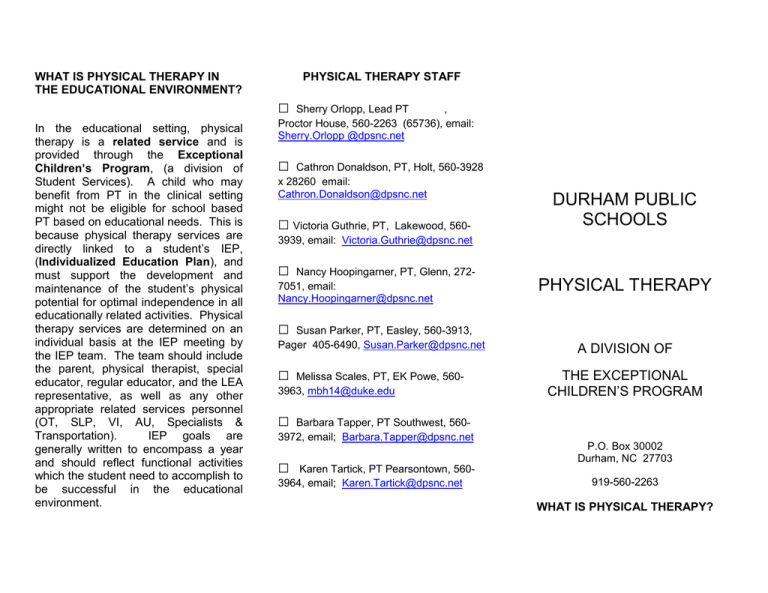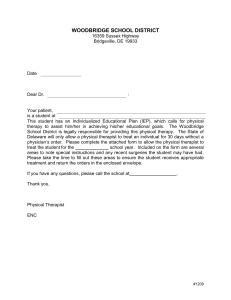□
advertisement

WHAT IS PHYSICAL THERAPY IN THE EDUCATIONAL ENVIRONMENT? In the educational setting, physical therapy is a related service and is provided through the Exceptional Children’s Program, (a division of Student Services). A child who may benefit from PT in the clinical setting might not be eligible for school based PT based on educational needs. This is because physical therapy services are directly linked to a student’s IEP, (Individualized Education Plan), and must support the development and maintenance of the student’s physical potential for optimal independence in all educationally related activities. Physical therapy services are determined on an individual basis at the IEP meeting by the IEP team. The team should include the parent, physical therapist, special educator, regular educator, and the LEA representative, as well as any other appropriate related services personnel (OT, SLP, VI, AU, Specialists & Transportation). IEP goals are generally written to encompass a year and should reflect functional activities which the student need to accomplish to be successful in the educational environment. PHYSICAL THERAPY STAFF □ Sherry Orlopp, Lead PT , Proctor House, 560-2263 (65736), email: Sherry.Orlopp @dpsnc.net □ Cathron Donaldson, PT, Holt, 560-3928 x 28260 email: Cathron.Donaldson@dpsnc.net □ Victoria Guthrie, PT, Lakewood, 5603939, email: Victoria.Guthrie@dpsnc.net □ Nancy Hoopingarner, PT, Glenn, 2727051, email: Nancy.Hoopingarner@dpsnc.net DURHAM PUBLIC SCHOOLS PHYSICAL THERAPY □ Susan Parker, PT, Easley, 560-3913, Pager 405-6490, Susan.Parker@dpsnc.net □ Melissa Scales, PT, EK Powe, 5603963, mbh14@duke.edu A DIVISION OF THE EXCEPTIONAL CHILDREN’S PROGRAM □ Barbara Tapper, PT Southwest, 5603972, email; Barbara.Tapper@dpsnc.net □ Karen Tartick, PT Pearsontown, 5603964, email; Karen.Tartick@dpsnc.net P.O. Box 30002 Durham, NC 27703 919-560-2263 WHAT IS PHYSICAL THERAPY? Physical Therapy means services provided by a licensed physical therapist or physical therapy assistant. A physical therapist is an allied health professional concerned with the prevention of physical disability, and the rehabilitation of individuals with conditions, resulting form prenatal causes, birth, illness, or injury. The purpose of physical therapy is to develop or restore neuromuscular and or sensorimotor function, control postural deviations to minimize disabilities, and to develop and maintain maximal performance levels within an individual’s capabilities. A pediatric physical therapist has knowledge of normal development and patterns of movement and is uniquely qualified to address gait, and gross motor skill development in children with special needs. The physical therapist in the educational setting provides educationally related screening, evaluation, treatment, consultation, inservice education for school personnel and community, and total program planning for students if their impairments are negatively impacting their ability to access their education. WHAT PHYSICAL THERAPY SERVICES ARE OFFERED IN DPS? If a child’s physical disability is directly impacting their ability to access their education, delivery of physical therapy may include the following: As Needed Sessions-provided for a student who is demonstrating minimal to no changes in his/her physical status. It usually involves monitoring equipment needs, classroom interventions, and consultation with educational staff as needed Intermittent Interval Sessionsprovided for a student who is functioning at or close to his/her maximal level of independence in the educational environment. The therapist designs a program to maintain the student’s functional status, meeting with the student and/or educational staff on a regular basis to monitor the program, problem solve, and train classroom personnel to ensure IEP goals are supported. Regular Sessions/Intervention-is indicated when a therapist’s contact is required because the skills needed to ensure IEP goal attainment, and student safety, require the expertise of a physical therapist. Students receiving weekly intervention are often working on “life skills.” The following are some but not all areas where a physical therapist might be involved in addressing a student’s needs in the school setting: ▪ Gross Motor Skill Development-generally provided in the preschool setting to promote optimal participation and safety in the classroom and on the playground. ▪ Positioning-in order to support the student in the most optimal posture for learning and to provide a variety of positional experiences throughout the school day. ▪ Ambulation Training-training with or without assistive devices to promote a student’s independence and ability to access their educational environment. ▪ Mobility Training- manual and or power wheelchair training to obtain maximal independent mobility within the educational environment ▪Transfer Skills-to permit the student to manage transfer activities for self care and, in order to attain optimal independence in the educational setting. ▪ Addressing architectural barriers, transportation needs and evacuation plans


